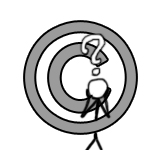Avoiding Copyright Infringement in 4 Easy Steps:
Step 1: Don’t publish stuff you didn’t create.
While sometimes this might be unrealistic, if you can avoid copying anything, there’s no reason to move on to any of the other steps. If you create it, you own it.
Step 2: Get permission from the owners.
If you need to use someone else’s content to complete your idea, the best bet here is to obtain permission from the author (or an authorized agent of the author). If you get permission, you don’t need to go to the next steps.
 This, too, is tricky. Original authors or creators of content may not own their creations. For example, if I want to put a clip from 30 Rock up on this blog, I might contact the show’s creator, Tina Fey, via her Twitter account (which I can no longer find?), and she could grant me “permission” to use the clip. That may be insufficient. I’m not sure of the specifics of their arrangement, but I’d probably have to go to NBC Universal to get clearance to use the clip. I may even have to go to NBC’s parent company (soon to be Comcast). [In a move sure to impress the web2.0 crowd, many videos on the NBC site include an embed link, allowing users to post some content].
This, too, is tricky. Original authors or creators of content may not own their creations. For example, if I want to put a clip from 30 Rock up on this blog, I might contact the show’s creator, Tina Fey, via her Twitter account (which I can no longer find?), and she could grant me “permission” to use the clip. That may be insufficient. I’m not sure of the specifics of their arrangement, but I’d probably have to go to NBC Universal to get clearance to use the clip. I may even have to go to NBC’s parent company (soon to be Comcast). [In a move sure to impress the web2.0 crowd, many videos on the NBC site include an embed link, allowing users to post some content].
Unless you are seeking to profit from someone else’s work, there is a good chance they will be fine with your use, so ask in advance. [This is probably less true with large corporations, like Fox or Comcast, who may require a licensing fee for even the smallest uses because they don’t need the free publicity you are giving their content].
Step 3: Check to see if yours is a fair use.
The law allows for certain uses of copyrighted content as “fair use.” To determine if your use is “fair use,” courts will look to:
The purpose and character of the use, including whether such use is of commercial nature or is for nonprofit educational purposes The nature of the copyrighted work The amount and substantiality of the portion used in relation to the copyrighted work as a whole The effect of the use upon the potential market for, or value of, the copyrighted work
The downside to fair use is that it operates as a defense. This means that if I used a clip from 30 Rock, without getting permission, and depended on fair use to protect me, NBC or Comcast could still bring a suit against me, and they could still file countless motions and discovery requests, each requiring the expert response of a copyright attorney. A copyright attorney is going to charge several hundred dollars an hour. The cost to me, even if I have a rightful claim to the content’s use, is likely to be thousands of dollars.
So, while you might be protected by fair use in a legal sense, financially, you probably shouldn’t rely on fair use alone.
Step 4: Attribute and pray.
If you do use someone else’s content on your site, or in your video or song, the simplest thing you can do to protect yourself is to give the original author credit and hope your use won’t offend the owner. If you don’t get sued, there’s no problem, right? No harm no foul. This step is obviously a last resort.
Sometimes, the lines blur. What if I post a video from 30 Rock or The Simpsons on my blog, but really all I’ve done is use YouTube’s “embed” feature to pull the content from YouTube to #law tag? The Citizen Media Law Project has a great post on this scenario, and I’d suggest reading it.
If you think someone has taken your content, read my previous post.



Trackbacks